I spent last evening with Kawasaki representatives and roughly 25 journalists and other guests at the Japanese American National Museum in Los Angeles. The occasion was the first display in the United States of the new Ninja H2 and H2R. Kawasaki served a delicious dinner, provided an interesting demonstration of Shodo Calligraphy, and allowed the scruffy journalists to rub elbows with the likes of Jay Leno (who has a new car/motorcycle show, as I understand it).
As Taiko drummers filled the high-ceiling hall with resonance, speeches from Kawasaki executives, at times dressed in ceremonial garb (sponsored by a sake company), led to the unveiling of both models.
We wanted to highlight aspects of the supercharged engine here, after our general introduction of the new models.
The supercharger is designed in a simple, lightweight manner. A centrifugal style is efficient, and conservative, requiring no intercooler, and no independent oil/oil cooler (being lubricated simply by engine oil).
Examining the bike in person, the layout couldn’t be more basic. A single-sided ram air system feeds the supercharger along the left side of the chassis. The supercharger itself is very compact, and is driven by the crank through two stepped gears (initially a 1.15x step, followed by a 8x planetary gear). As a result, the impeller turns at up to 130,000 rpm (9.2 times the maximum crank speed).
The impeller itself is machined from a forged aluminum block, with six longer blades and 12 blades in total. The blades have grooved surfaces to direct airflow.
The impeller can pump an amazing 53 gallons of air per second. Peak air pressure achieved is 2.4 times atmospheric (35 psi).
The resulting street-legal H2 weighs just 524.7 pounds wet (all fluids, including 4.5 gallons of fuel). Remarkably light for a machine incorporating a supercharger.
No horsepower figure has been provided for the street-legal H2, but the closed-course H2R puts out slightly more than 300 hp at the crank. More horsepower always equals more heat, as you can readily see in the Cycle World video of an H2R dyno run.
It is worth noting that the H2 has an engine which is identical to the engine in the H2R, with the exception of the camshafts, head gaskets and clutch. Needless to say, a stock H2 will have huge tuning potential. In this regard, Kawasaki states “the entire engine was designed to be able to handle stresses 1.5-2x greater than a naturally aspirated liter-class engine.” Here is the Kawasaki press release on the H2, with a sprinkling of additional photos taken by yours truly at the museum last evening:
The launching point for the development of the Ninja H2™ motorcycle was a strong desire to offer riders something they had never experienced before. Convinced that an extraordinary riding experience would not be found by merely building on the performance of existing models, the design team committed to developing the “ultimate motorcycle” from a clean slate.
The bike needed to deliver intense acceleration and ultra-high top speed, coupled with supersport-level circuit performance. To realize this goal, help was enlisted from other companies within the Kawasaki Heavy Industries, Ltd (KHI) group, precipitating an unprecedented level of collaboration.
Ninja H2 development pursued two paths. The first was the Ninja H2™R, which is a closed-course model that allowed the unadulterated pursuit of performance without the limitations of street homologation. This motorcycle is followed by the Ninja H2 street model, which is based closely on the H2R but meets all market regulations. The results are incredible, with both models offering a sensory experience surpassing anything else that riders can find today.
A supercharged engine closely based on the same powerplant as the Ninja H2R powers the Ninja H2. High output notwithstanding, the compact design is on par with power units found in supersport liter-class models. The key to achieving this incredible performance lies in the supercharger – a motorcycle-specific unit designed completely in-house with technology from the Gas Turbine & Machinery Company, Aerospace Company and Corporate Technology Division.
HIGHLIGHTS OF THE 2015 KAWASAKI NINJA H2™:
- Street model based on closed-circuit Ninja H2R
- 998cc four-cylinder engine fitted with Kawasaki supercharger for intense acceleration
- Supercharger uses planetary gears, spins at up to 130,000rpm and develops up to 20.5psi boost pressure
- Dog-ring transmission allows fast shifting and works with standard quick shifter
- Bodywork developed with Kawasaki Aerospace Company to generate downforce
- Kawasaki River Mark used to indicate combined Kawasaki Group technology
- Trellis frame used for first time to provide strength, controlled flex and air circulation
- Single-sided swingarm used for first time, mounted to engine as a stressed member
- KYB® AOS-II Air-Oil Separate cartridge fork, adjustable KYB rear shock
- 330mm front discs with four-piston Brembo® calipers
- Multi-mode traction control, launch control, engine braking control, ABS and a quick shifter
KHI Group’s technology was not limited to the supercharger. Advanced technological know-how shared from other Group companies is found throughout the innovative engine and chassis design. For example, the aerodynamic mirror mounts were designed with assistance from Kawasaki’s Aerospace Company to add stability for high-speed riding. This highlights the collaboration, and the level of technology poured into the model was the reason the Kawasaki River Mark* is prominently displayed on the upper cowl.
When it came time to name this model, “Ninja®” was an obvious choice because it is synonymous with Kawasaki performance, and is shared by legendary models over the years. It is also named for another iconic model: the “H2” (also known as the 750SS Mach IV in some markets), which was powered by a two-stroke 748cc triple and boasted the sort of intense acceleration that made it a worldwide sensation. For a motorcycle that delivers supersport-level handling coupled with the kind of acceleration no rider has experienced before, Ninja H2 was the perfect name. And so Kawasaki is again ready to unleash a new sensation upon the world.
*The Kawasaki River Mark is a long-time symbol of KHI dating back to the 1870s. As a policy, its use on products is limited to models with historical significance. But permission was granted for the Ninja H2 to use this special symbol.
THE QUEST FOR POWER
In order to offer intense acceleration, it was essential that the engine was able to produce big power. While a large-displacement engine could easily provide high output, the engineers preferred it to be compact to help ensure a lightweight, compact motorcycle.
Using a supercharged engine enabled these engine design requirements to be met. Aside from minor differences in the engine, as well as an intake and exhaust system tailored for street use to meet noise and emissions standards, the supercharged engine is essentially the same as the closed-course Ninja H2R. It delivers intense acceleration unlike anything you can experience on a naturally aspirated bike. Designed in-house, the immense potential of the compact, highly efficient engine is a testament to the technology possessed by the KHI Group.
SUPERCHARGED 998cc IN-LINE FOUR
KHI-DESIGNED SUPERCHARGER
The supercharger used by the Ninja H2 was designed by Kawasaki motorcycle engineers with assistance from other companies within the KHI Group, namely the Gas Turbine & Machinery Company, Aerospace Company, and Corporate Technology Division. Designing the supercharger completely in-house allowed it to be developed to perfectly match the engine characteristics of the Ninja H2. The highly efficient, motorcycle-specific supercharger was the key to achieving the maximum power and intense acceleration the engineers wanted.
- One of the greatest benefits of designing the supercharger in-house and tailoring its design to match the character of the Ninja H2 engine was that engineers were able to achieve high-efficiency over a wide range of conditions – something that would not have been possible by simply using an aftermarket automotive supercharger.
- The importance of high efficiency in a supercharger is so that, as air is compressed, power-robbing heat gain is minimal. And while many superchargers are able to offer high-efficiency operation in a limited range of conditions, the KHI-designed supercharger for the Ninja H2 offers high efficiency over a wide range of pressure ratios and flow rates – so it is over a wide range of engine- and vehicle speeds. This wide range of efficient operation (similar to having a wide powerband) translates into strong acceleration.
- The supercharger’s high efficiency and minimal heat gain meant an intercooler was unnecessary, allowing savings in both weight and space.
- The supercharger is a centrifugal-type unit – ideal for high-RPM performance – with a cast aluminium housing.
- The unit is located centrally, behind the cylinder bank, in the best position to evenly distribute compressed air to all four cylinders.
- The supercharger uses engine oil for lubrication. By not requiring an independent oil source, it contributed to the compact, lightweight design.
- The supercharger is driven by a planetary gear train, which runs off the crankshaft. Designing the gear train using technology from Kawasaki’s Aerospace Company resulted in a compact unit with minimal power loss.
- The gear train increases the impeller speed up to 9.2x the crank speed (1.15x step gear with an 8x planetary gear). This means at a maximum engine speed of approximately 14,000rpm, the impeller shaft is spinning at almost 130,000rpm.
- The impeller is formed from a forged aluminium block using a 5-axis CNC machine to help ensure precision and durability. The 69mm impeller features six blades at the tip, expanding to 12 blades at the base. Grooves etched into the blade surfaces help direct the airflow.
- The impeller’s pumping capacity is more than 200 liters/second (measured at atmospheric pressure), with intake air reaching speeds of up to 100m/s. After passing through the supercharger, air pressure is increased to as much as 2.4x atmospheric pressure (35psi).
POWER UNIT DESIGNED FROM THE CLOSED-COURSE NINJA H2R
Despite its familiar in-line four configuration, the Ninja H2 engine is loaded with technology developed specifically for this supercharged engine: some new, others with know-how from the Kawasaki Group.
Every component of the engine was chosen to achieve a certain function. In order to accommodate the higher air pressure from the supercharger, as well as to help ensure reliability of the closed-course Ninja H2R, the entire engine was designed to be able to handle stresses 1.5-2x greater than a naturally aspirated liter-class engine. In fact, aside from its camshafts, head gaskets and clutch, the engine is the same as the unit found in the Ninja H2R.
- The combustion chamber design is complemented by flat piston crowns. The shape, inspired by the pistons used in the Green® Gas Engine developed by Kawasaki’s Gas Turbine & Machinery Company, also contributes to the engine’s anti-knock performance.
- While the intake valves are stainless steel, the exhaust valves needed to be able to withstand the supercharged engine’s high-temperature exhaust gases. So the exhaust valves are formed from two materials that are friction-welded at the center: Inconel – an extremely heat-resistant alloy – is used for the valve head and lower half of the stem; while heat-resistant steel is used for the upper half. The stems are tapered, varying in diameter from 4.5-5mm.
- A dummy head is used during the cylinder honing process. The more precise circular and cylindrical shape that results allows the use of low-tension piston rings, which help reduce mechanical loss.
- The pistons are cast, since they offer better strength than forged pistons under the very high temperatures generated by the high-performance supercharged engine. A unique casting process (similar to forging) sees unnecessary material removed, with hollows created to achieve the ideal thickness. This produces a piston weight on par with forged pistons.
DOG-RING TRANSMISSION
To facilitate smooth, quick shifting, a dog-ring-type transmission was selected. This is similar to the kind of transmission commonly found in MotoGP™ or Formula 1®, and was developed with feedback from the Kawasaki Racing Team.
- Unlike a standard motorcycle transmission, where the shift forks slide the gears into position, the gears remain in place in a dog-ring transmission. Only the dog rings move, sliding into position to engage the desired gear.
- Because the dog rings are lighter than transmission gears, this type of transmission offers a significantly lighter shift effort. Shift feel is also improved, and a much quicker shift is possible, facilitating quicker acceleration.
HYDRAULIC CLUTCH & BACK-TORQUE LIMITER
A high-quality hydraulic clutch offers less maintenance and helps to ensure that the initial bite point can be maintained. By using Brembo® components, superb linearity and smooth actuation are further benefits.
- Brembo parts are used for both the clutch lever’s radial-pump master cylinder and the clutch release mechanism. They receive extra attention from Brembo before being shipped to Kawasaki. Each part is examined and adjusted to help eliminate any ineffective (idle) stroke, resulting in superb control.
- The back-torque limiter contributes to stability by helping prevent wheel hop when downshifting. The back-torque limiter is also adjustable.
MAXIMIZING AIRFLOW EFFICIENCY
To maximize the performance of the supercharged engine, airflow efficiency was of paramount importance. How air enters the supercharger, how the compressed air enters the engine, and how the combusted air/fuel mixture is discharged were all carefully analyzed for maximum efficiency to help ensure the airflow characteristics would create the desired engine character.
RAM AIR INTAKE
- Air supplied to the supercharger enters via a single ram air intake in the left side of the upper cowl. The total frontal area is approximately 3x the area of the supercharger inlet.
- A ram air duct was designed to take the fresh air to the supercharger in as straight a line as possible. Its shape was created to match the impeller characteristics, further contributing to the engine’s output.
- For optimum efficiency for the Ninja H2 engine, the air cleaner is positioned directly in front of the supercharger.
ALUMINIUM INTAKE CHAMBER
- The intake chamber has a large volume (6 liters), and is ideally shaped for high efficiency and engine output.
- Being constructed from rigid aluminium offers two advantages:
1) Aluminium offers excellent surface heat dissipation, helping to keep the intake air cool;
2) The rigid structure helps to ensure an airtight seal for the pressurized air at approximately 2-bar (29.4psi). - Inside the intake chamber, newly developed Kawasaki technology contributes to the engine’s high performance. The top injectors spray fuel onto stainless steel mesh positioned over the intake funnels. This has an ordering effect, creating a more uniform air/fuel mixture as the fuel is drawn into the intake funnel. The mesh also promotes fuel misting, which helps cool the intake air and increases combustion chamber efficiency.
ELECTRONIC THROTTLE VALVES
Kawasaki’s fully electronic throttle actuation system enables the ECU to control the volume of fuel (via fuel injectors) and air (via throttle valves) delivered to the engine. Ideal fuel injection and throttle valve position results in smooth, natural engine response and the ideal engine output. The system also makes a significant contribution to reduced emissions.*
* The system enables more precise control of KTRC (Kawasaki Traction Control), and facilitates implementation of other electronic systems like KLCM (Kawasaki Launch Control Mode) and Kawasaki Engine Braking Control – see below.
INTAKE & EXHAUST PORTS, CAMSHAFT PROFILES
- The intake ports are polished to help ensure smooth air/fuel flow and minimize resistance.
- Straight exhaust ports – one for each exhaust valve – do not converge in the cylinder head. The straight-line design enables the most efficient removal of air from the combustion chamber and also contributes to efficient combustion chamber filling.
- Camshaft profiles were optimized for the Ninja H2 engine and are tuned to offer strong low-speed torque.
EXHAUST SYSTEM
- The entrance to the header pipes is oval to match the two exhaust ports per cylinder. Partly formed by hydroforming, each header pipe tapers from an oval to a round cross-section. The collector pipes are also hydroformed.
- Designed to suit the output and characteristics of the Ninja H2 engine, the stainless steel header pipes have a 45mm diameter. For the ideal exhaust pressure, all four header pipes are connected.
- The exhaust system also includes a compact under-engine pre-chamber, with double-wall construction for rigidity. This construction helps reduce radiating noise and high frequency exhaust noise.
- The single right-side silencer ensures noise and exhaust gas emissions meet market regulations.
KEEPING THE ENGINE COOL
Cooling performance can be a substantial limiting factor for engine output, so maximizing the cooling efficiency was a key consideration when designing the engine. In addition to helping ensure that intake air remain as cool as possible, the heat generated by the high-output engine needs to be dissipated, and engine components themselves need to be kept cool to help ensure efficient operation. The extensive pursuit of cooling performance led to a highly complex engine layout, both for the lubrication system (oil is used for cooling as well as lubrication) and the cooling system.
CYLINDER HEAD
A number of considerations were given to the aluminum cylinder head design to provide the necessary cooling performance. The large coolant passageways result in excellent cooling for the combustion chamber.
- The water jacket extends between the twin exhaust ports of each cylinder, while large coolant passageways around the spark plug holes and valve seat areas offer superior cooling. The steel spark plugs and valve seats have a greater tendency to retain heat than the aluminum cylinder head, so cooling them is very important and makes a big difference to temperature control.
OIL JETS
In the interest of keeping the engine compact and simple, a single lubrication system provides cooling oil for the engine components, supercharger and the transmission.
- Oil jets lubricate the supercharger chain in two places – at the contact points where the chain meets the upper and lower sprockets.
- In addition to the two oil jets, the supercharger drivetrain’s lower gear has an oil passage.
- Inside the engine, there are two oil jets per cylinder to ensure the hot pistons are effectively cooled.
- Transmission oil jets (used for the first time in a Kawasaki motorcycle) enable a compact transmission with high durability.
LUBRICATION SYSTEM COMPONENTS
Because the lubrication system is servicing so many components, oil volume is 5.0 liters (1.3 gallons) – that is about 35% more than usually seen in a naturally aspirated engine of the same displacement.
RADIATOR
- The radiator’s size and capacity is on par with those found on current liter-class supersport motorcycles, but it offers superior cooling performance because it flows approximately 1.5x more air than other bikes. This was found to be more effective than simply increasing the size of the radiator.
- Airflow is facilitated by the compact side-cowl design, and leaving the lower part of the engine open (except for the small under cowls) to the air was designed to extract hot air.
LIQUID-COOLED OIL COOLER
- A liquid-cooled oil cooler adds to the extremely high cooling performance necessary for the high output engine.
HIGH-SPEED STABILITY & LIGHT HANDLING
Designed for the performance parameters of the closed-course Ninja H2R and shared with the street-going Ninja H2, the objectives for the chassis were to provide superb motorcycle composure at ultra-high speeds, while offer cornering performance that allows the rider to enjoy riding on a circuit, and finally to be very accommodating to the rider. Ordinarily, high-speed stability can easily be achieved with a long wheelbase, but a shorter wheelbase was selected to achieve the compact overall package and sharp handling that were desired. So the frame needed to not only be stiff, but also to be able to absorb external disturbances, which could otherwise unsettle the chassis when encountered at high speed. A trellis frame provided both the strength to harness the incredible power of the supercharged engine, and the balanced flex to achieve stability for high-speed riding.
INNOVATIVE CHASSIS DESIGN
TRELLIS FRAME
Using a trellis frame offered an elegant, lightweight solution to meeting the performance requirements for the chassis of the closed-course Ninja H2R. Able to harness the massive power of its engine, it has a balance of stiffness and flexibility that enables a high level of stability while being able to handle external disturbances at high speeds. Its open design also helps dissipate heat generated by the supercharged engine.
- Development of the trellis frame made good use of the latest analysis technology and substantial test rider feedback.
- Pipe diameter, thickness and the bend of each piece of the trellis frame were carefully selected to obtain the necessary stiffness for each part of the frame. The trellis pieces are primarily made from high-tensile steel.
SWINGARM MOUNTING PLATE
This innovative new chassis mechanism allows the engine to act as part of the frame.
- The swingarm mounting plate bolts to the back of the engine. The swingarm pivot shaft goes through this plate, essentially allowing the swingarm to be mounted directly to the engine.
- Thanks to the swingarm mounting plate, the frame does not need to use crossmembers for stability. This contributes to the frame’s low weight.
SINGLE-SIDED SWINGARM
The Ninja H2 and H2R feature Kawasaki’s first single-sided swingarm.
- Having a single-sided swingarm allows the exhaust silencer to be mounted closer to the bike centerline, providing a high bank angle for sporty cornering.
CHASSIS GEOMETRY
To ensure fun at high speeds as well as on the racing circuit, a compact package was desired. Therefore, the chassis geometry is very similar to that of a liter-class supersport motorcycle.
FRONT SUSPENSION
KYB® AOS-II racing suspension makes its debut on a street bike.
- Based on the Air-Oil Separate cartridge fork that was developed for motocross racing.
- Designed for low friction, the 43mm front fork offers superb action, with a smooth initial action followed by strong damping at the end of the stroke.
- As the suspension works, a large 32mm free-floating piston at the bottom of the oil-damping cartridge pumps oil up to a sealed area between the inner and outer tubes. The oil in this area provides a friction-reducing film on which the tubes can slide against each other, resulting in an extremely smooth action.
REAR SUSPENSION
Fully adjustable KYB rear suspension offers superb stability.
- The top of the rear shock mounts to the swingarm mounting plate. Again, doing away with the need for frame crossmembers.
- The bottom of the rear shock is mounted via a revised Uni-Trak® linkage that offers excellent feedback for rear tire grip. The new linkage, situated below the swingarm, also mounts to the swingarm mounting plate.
BRAKES
Given the high-speed potential of the Ninja H2, the brakes chosen were the best available for a production motorcycle. Special tuning helped ensure that all play in the lever was removed from the system, so that when the brakes are applied they respond immediately.
- A pair of massive 330mm Brembo semi-floating discs, with a thickness of 5.5mm, delivers superb braking force.
- The brake discs have grooves running down the center of the outer edge to increase the discs’ surface area for greater heat dissipation.
- Dual radial-mount Brembo cast aluminum monobloc calipers grip the front discs. The rigid, opposed four-piston calipers with 30mm pistons contribute to the superb braking force of the Ninja H2, as well as a high-quality image.
- A Brembo radial-pump master cylinder and reservoir receive extra attention before being shipped to Kawasaki. Each part is examined and adjusted to help eliminate any play in the lever stroke.
- A large 250mm disc generates strong braking force at the rear.
ORIGINAL WHEEL DESIGN
The cast aluminum wheels were designed specifically for the Ninja H2 and H2R.
- The star-pattern five-spoke wheel design was selected based on the optimum balance of rigidity for high-speed performance.
- The analysis technology used in the wheel development comes from Kawasaki’s World Superbike involvement.
- Knurling on the inside of the rear wheel rim helps prevent tire slipping on the wheel that could be caused by the massive torque generated by the engine.
HIGH-SPEED TIRES
To help ensure sufficient tire durability when riding at high speed, high-performance tires must be used.
- A massive 200mm rear tire transmits the Ninja H2’s power to the tarmac.
- The Ninja H2 is able to use high-performance street tires.
SHAPED FOR SPEED
As speed increases, wind resistance increases exponentially. To enable high-speed operation, a combination of high power and slippery aerodynamics was needed. With power requirements taken care of by the supercharged engine, the next step was to design bodywork that provides both minimal drag and good control when riding at high speed. Assistance from Kawasaki’s Aerospace Company was enlisted in creating the aerodynamically sculpted bodywork to provide maximum aerodynamic efficiency.
AERODYNAMICS
AERODYNAMICALLY DESIGNED BODYWORK
It is no accident that when viewed from the side, the Ninja H2 and H2R do not have the aggressive forward-canted stance of most modern supersport motorcycles. While supersport bikes use their front-leaning attitude to aid quick steering, at the speeds for which the closed-course Ninja H2R was designed, such a posture would create drag, which would hinder top speed potential. Therefore, the H2 stance is very neutral, almost flat – like a Formula 1 car – to make the body as aerodynamically sleek as possible.
- The aerodynamically shaped upper cowl uses lips and lines to direct airflow over its surface.
- The upper cowl locates the ram air intake in the most efficient position.
- Compact side cowls and under cowls were designed to assist heat dissipation.
- The rear cowl has an extremely compact three-piece design. The center portion is taller, creating an aerodynamic form that helps smooth airflow as it passes the rider. Wind is also able to pass between the center and side pieces, further reducing air resistance.
GENERATING DOWNFORCE
In order to maintain both straight-line stability and the ability to change direction while running at high speed, the Ninja H2 features a number of aerodynamic devices to help ensure the front wheel has strong contact with the ground.
- The design of the upper cowl incorporates a chin spoiler. Rather than being a cosmetic flourish, it produces downforce that contributes to high-speed stability.
- Further contributing to high-speed stability, the Ninja H2 features mirror mounts with airfoil cross-sections. Like the wings on the closed-course Ninja H2R, the mounts were also designed by Kawasaki’s Aerospace Company. The trailing edges are equipped with Gurney flaps that increase the effectiveness of the simple airfoil shape, allowing greater downforce to be generated by the small surface.
MAN / MACHINE INTERFACE
Since the Ninja H2 was not intended to be a pure race bike, it did not need the spartan accommodations found on most purpose-built supersport models. As a result, the Ninja H2’s man / machine interface enables riders to enjoy the bike’s performance with a degree of comfort. While the riding position, ergonomics and cockpit layout were designed first and foremost to put the rider in the best position to control this amazing machine, the impression from the rider’s perspective is not one of austerity, but is more about quality, high-tech control and the impeccable fit and finish.
SEATING FOR ONE
RIDING POSITION & ERGONOMICS
With the kind of riding the Ninja H2 was designed for, and a desire for a compact package resulted in a riding position similar to that of a supersport bike without being quite as aggressive. As enjoyment of the intense acceleration and high-speed capability was the first priority, a solo seat for the rider is the only seating provided.
- The riding position was designed for high speed and circuit riding. The rider triangle is similar to that of the Ninja® ZX™-10R motorcycle, but more relaxed.
- To help support the rider during intense acceleration, hip-supporting pads flank the rear of the seat. The hip support is adjustable 15mm backward to suit the rider’s size.
INSTRUMENTATION & CONTROLS
The advanced, high-tech design of the instrumentation conveys the image of piloting a fighter jet. Handlebar control switches put all mode selection and display options at the rider’s fingertips.
- The new instrumentation design combines a full digital LCD screen with an analog-style tachometer.
- The LCD screen uses a black / white reverse display (white characters on a black background), contributing to the high-quality image.
- In addition to the digital speedometer and gear position indicator, display functions include: odometer, dual trip meters, current mileage, average mileage, fuel consumption, coolant temperature, boost indicator, boost (intake air chamber) temperature, stopwatch (lap timer), clock and the Economical Riding Indicator.
- The tachometer design uses an actual needle, but the black dial “face” looks blank until engine speed increases. Backlit RPM numbers light up to chase the tachometer needle as it moves around the dial.
- Compact new switch design allows all instrument functions to be controlled from the handles.
ELECTRONIC RIDER SUPPORT
Complementing the Ninja H2’s incredible engine and chassis performance, advanced electronics work behind the scenes to provide rider support. Depending on rider preference, many of the systems may be turned off. And while the high-performance engine was designed to be accommodating even without the benefit of rider aids, when electing to fully experience the Ninja H2’s intense acceleration or high-speed potential, these systems are available to provide an extra degree of rider confidence.
ENGINE & CHASSIS MANAGEMENT SYSTEMS
KTRC (KAWASAKI TRACTION CONTROL)
The new KTRC system used on the Ninja H2 combines the best elements of Kawasaki’s earlier traction control systems. Multi-level modes offer riders a greater number of settings to choose from, with each mode providing a different level of intrusion to suit riding conditions and rider preference. And all modes are designed to manage output when sudden wheel slip occurs. The new system offers both enhanced sport riding performance and the peace of mind to negotiate slippery surfaces with confidence.
- Riders can choose from three modes, each offering a progressively greater level of intrusion. Each of these modes also has three rider-selectable levels, adding more or less intrusion (rider preferences for each mode are programmable for on-the-move selection), giving a total of nine possible settings. Riders may also elect to turn the system off.
- Mode 1 is for the circuit, Mode 2 for the street, and Mode 3 for wet pavement conditions. A Rain Mode is also available, as outlined below.
- Using complex analysis, the system is able to predict when traction conditions are about to become unfavorable. By acting before slippage exceeds the range for optimum traction, it means that drops in power can be minimized, resulting in smoother operation.
- Rain Mode can be turned on and off independently from KTRC. Activating Rain Mode sets KTRC to Mode 3+, and limits power output, torque and response. Similar to a Low Power setting, maximum engine output is less than 50% of full power, with a gentler throttle response.
KLCM (KAWASAKI LAUNCH CONTROL MODE)
Designed to assist the rider by optimizing acceleration from a stop, KLCM electronically controls engine output to prevent wheelspin and minimize wheelies when launching.
- Riders can choose from three modes, each offering a progressively greater level of intrusion. Each mode allows the rider to launch from a stop with the throttle held wide open.
KAWASAKI ENGINE BRAKE CONTROL
The system allows riders to select the amount of engine braking they prefer.
- When the system is activated (by selecting “LIGHT” in the Engine Braking settings), the engine braking effect is reduced, providing less interference when riding on the circuit.
KIBS (KAWASAKI INTELLIGENT ANTI-LOCK BRAKE SYSTEM)
Kawasaki’s supersport-style ABS is standard equipment on the Ninja H2. This is based on the same system used on the Ninja ZX-10R, with programming and settings revised to suit the performance parameters of the Ninja H2.
- High-precision brake pressure control enables the system to avoid reduced brake performance due to excessive pressure drops, allows lever feel to be maintained when KIBS is active, and helps ensure ABS pulses feel smooth (not heavy).
- High-precision brake pressure control also offers a number of sport riding benefits:
Rear lift suppression
2. Minimal kickback during operation
3. Accounts for back-torque
KQS (KAWASAKI QUICK SHIFTER)
Ninja H2 is the first Kawasaki motorcycle to be fitted with a standard quick shifter.
- Complementing the engine’s strong power and the dog-ring transmission, a contactless-type quick shifter enables rapid upshifts for seamless acceleration.
ÖHLINS ELECTRONIC STEERING DAMPER
Unlike a mechanical steering damper – in which the settings, once fixed, must cover all riding conditions and speeds – the damping characteristics are changed electronically, according to vehicle speed, and the degree of acceleration or deceleration.
At low speeds, the settings were chosen so that damping does not interfere with the bike’s intrinsic lightweight handling. At high speeds, damping increases to provide enhanced stability.
- Kawasaki’s electronic steering damper was developed with Öhlins, one of the most popular and respected steering damper manufacturers.
- The electronic steering damper provides just the right amount of damping based on what the bike is doing. Using input from the rear wheel speed sensor (provided via the engine ECU), the electronic steering damper’s ECU determines the vehicle speed as well as the degree the bike is accelerating or decelerating.
STYLING & CRAFTSMANSHIP
Wanting to ensure a bold design worthy of a model that carries both the “Ninja” and “H2” names, the prime styling concept for the Ninja H2 was “Intense Force” design. As a flagship for the Kawasaki brand, it needs to have presence, and styling that reflects its incredible performance. But the design is much more than cosmetic. While its edged styling certainly looks the part, the Ninja H2 also possesses a functional beauty: each piece of its bodywork was aerodynamically sculpted to enhance high speed stability; the cowling design also maximizes cooling performance and heat dissipation, aiding the engine’s incredible output; and the ram air duct is ideally positioned to bring fresh air to the supercharger.
More than any Kawasaki motorcycle to date, the Ninja H2 is a showcase of craftsmanship, build quality and superb fit and finish – right down to the high-tech mirror-like paint specially developed for this model.
INTENSE FORCE DESIGN
STYLING & CRAFTSMANSHIP DETAILS
- Machined surfaces on the wheel spokes and painted rims contribute to a high-quality finish.
- High-level attention to detail is evident in the numerous machined fastener designs (such as the steering stem and rear hub nuts).
- Welding bead quality for the trellis frame is uniformly high, contributing to the Ninja H2’s superb fit and finish. Depending on the weld, some are efficiently and precisely welded by Kawasaki robots, while others are welded by expert Kawasaki craftsmen.
LIGHTING EQUIPMENT
Ninja H2 is equipped with all the lights needed for street-legal operation. And with the exception of the bulb illuminating the license plate, all lighting equipment on the Ninja H2 uses LEDs.
- The bright, compact LED headlamp is positioned low, at the front of the upper cowl, contributing to the “Intense Force” design.
- The design of the LED front position lamps brings to mind the fangs of a predator.
- The elegant LED tail light is flanked by surface-emitting LED position lamps.
- New LED rear turn signals designs feature an inner lens, surface texturing and surface-emitting LEDs that contribute to the bike’s high-quality image.
HIGH-TECH PAINT
The Kawasaki original silver mirror-like paint used on the Ninja H2 – known as Mirror Coated Black – was developed by Kawasaki specifically for motorcycles. The highly reflective surface adds to the bike’s stunning design.
- In the shade, the paint appears black, but once in the sunlight its highly reflective surface takes on the appearance of the surrounding scenery. The stark difference in the way the paint appears in the light and shade emphasizes the beautiful curvature of the bike’s sculpted bodywork.
- While this kind of paint is similar in appearance to what has been used by top custom builders, this is the first time it has been used on a mass-production vehicle in either the automotive or motorcycle industries. Strict Kawasaki quality control measures help to ensure a long-lasting finish.
- The highly reflective surface is created by inducing a silver mirror-like reaction (a chemical reaction between a solution of silver ions and a reducing agent) that forms a layer of silver. This silver (Ag) layer is what creates the paint’s glass-like metal appearance. Compared to candy paints, which use aluminum flakes to generate a sparkling effect, the Ag layer appears as a uniform metallic surface.
- In the shade the Ag layer is translucent, allowing the base coat color to show through. This gives the paint a deep, three-dimensional quality.
- While the multiple layers of paint on typical production vehicles are applied by robot painters, each layer of the paint on the Ninja H2 – from primer to clearcoat – is carefully finished by hand by Kawasaki craftsmen to ensure a flawless, lustrous surface. Twice the layers of clearcoat (two on standard pieces, four on pieces with decals) adds to the high-quality finish.
- The paint on the fuel tank is finished with a UV coat (the only layer where robot painters are used) to protect the tank’s brilliant finish.
KAWASAKI RIVER MARK
Special permission was obtained to use the River Mark on the Ninja H2. Its use is reserved for models of historical significance.
HIGH-PRECISION PRODUCTION
Unlike a regular mass-production model, the high-precision production of the Ninja H2 requires greater hands-on participation by skilled Kawasaki craftsmen. So each step, from metalworking, treatment, welding and painting to assembly, fine-tuning and inspection is carefully attended to create a product of superior quality. Within Kawasaki’s Akashi Factory, production takes place in an area dedicated exclusively to the Ninja H2 motorcycle.
COLOR
The Kawasaki Ninja H2 is only available in its very special Mirror Coated Black paint.
ORDERING INFORMATION
The Kawasaki Ninja H2R and H2 are limited-release production motorcycles, available for a short time in select markets. In order to reserve one of the world’s first supercharged production streetbikes, make a deposit at your local authorized Kawasaki dealer no later than December 19, 2014. Reservations will be taken on a first-come, first-served basis and are secured only with a deposit.
ABOUT KAWASAKI
Kawasaki Heavy Industries, Ltd. (KHI) started full-scale production of motorcycles over a half century ago. The first Kawasaki motorcycle engine was designed based on technical know-how garnered from the development and production of aircraft engines, and Kawasaki’s entry into the motorcycle industry was driven by the company’s constant effort to develop new technologies. Numerous new Kawasaki models introduced over the years have helped shape the market, and in the process have created enduring legends based on their unique engineering, power, design and riding pleasure. In the future, Kawasaki’s commitment to maintaining and furthering these strengths will surely give birth to new legends.
Kawasaki Motors Corp., U.S.A. (KMC) markets and distributes Kawasaki motorcycles, ATVs, side x sides, and Jet Ski® watercraft through a network of almost 1,200 independent retailers, with close to an additional 7,400 retailers specializing in general purpose engines. KMC and its affiliates employ nearly 3,100 people in the United States, with approximately 300 of them located at KMC’s Irvine, California headquarters.
Kawasaki’s tagline, “Let the good times roll.™”, is recognized worldwide. The Kawasaki brand is synonymous with powerful, stylish and category-leading vehicles. Information about Kawasaki’s complete line of powersports products and Kawasaki affiliates can be found on the Internet at www.kawasaki.com.
# # #
2015 Kawasaki Ninja H2™ Specifications*
| SPORTBIKES SPEC TEMPLATE | Ninja H2 |
| Engine | Liquid-cooled, 4-stroke in-line four |
| Displacement | 998cc |
| Bore x Stroke | 76 x 55mm |
| Compression Ratio | 8.5:1 |
| Fuel System | Fuel injection: 50mm x 4 with dual injection |
| Intake System | Kawasaki supercharger |
| Cooling System | Water-cooled |
| Lubrication | Forced lubrication, wet sump with oil cooler |
| Ignition | Digital |
| Transmission | 6-speed, return, dog-ring |
| Final Drive | Chain |
| Frame Type | Trellis, high-tensile steel, with swingarm mounting plate |
| Rake/Trail | 24.4˚ / 4″ |
| Fuel Capacity | 4.5 gallons |
| Front Suspension / Wheel Travel | 43mm inverted fork with rebound and compression damping, spring preload adjustability and top-out springs / 4.7 |
| Rear Suspension / Wheel Travel | New Uni-Trak® with gas-charged shock, piggyback reservoir, dual-range (high/low-speed) compression damping, rebound damping and preload adjustability, and top-out spring / 5.3″ |
| Front Tire Size | 120/70 ZR17 M/C (58W) |
| Rear Tire Size | 200/55 ZR17 M/C (78W) |
| Front Brakes | Dual radial-mount, opposed 4-piston calipers, dual semi-floating 330mm discs |
| Rear Brakes | Opposed 2-piston calipers, single 250mm disc |
| Overall Length | 82″ |
| Overall Width | 30.3″ |
| Overall Height | 44.3 |
| Overall Height Windscreen Lowered/Raised | N/A |
| Ground Clearance | 5.1″ |
| Seat Height | 32.5″ |
| Curb Weight** | 524.7 lb |
| Wheelbase | 57.3 |
| Color Choices | Mirror Coated Black |
| MSRP | $25,000 |
| Warranty | TBD |
| Kawasaki Protection Plus (optional) | TBD |
| Wholesale Distributor | Kawasaki Motors Corp., U.S.A. 9950 Jeronimo Road, Irvine, California 92618 949-770-0400 www.kawasaki.com |
*Specifications are subject to change. Media are encouraged to visit www.kawasaki.com for most current specifications.
**Curb weight includes all necessary materials and fluids to operate correctly, full tank of fuel (more than 90 percent capacity) and tool kit (if supplied).


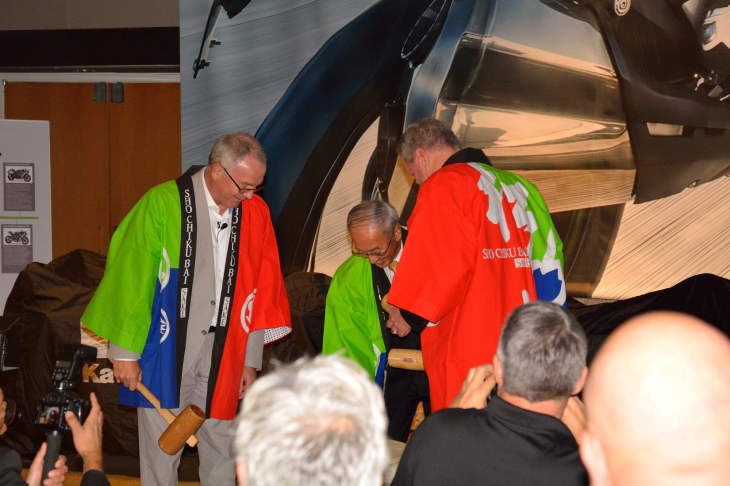
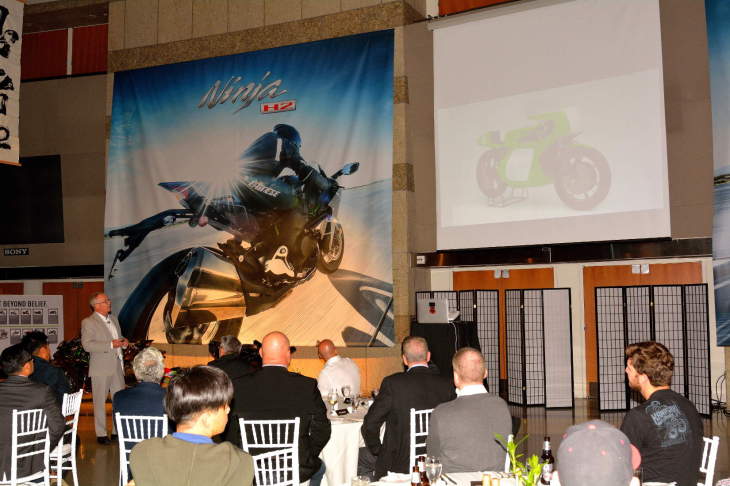
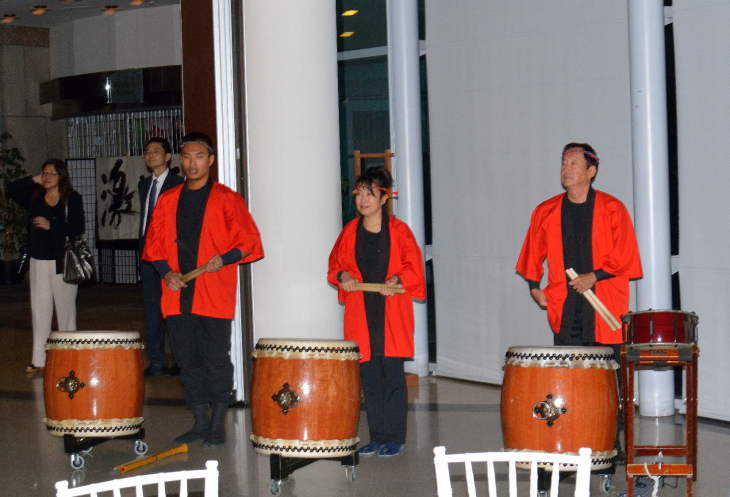
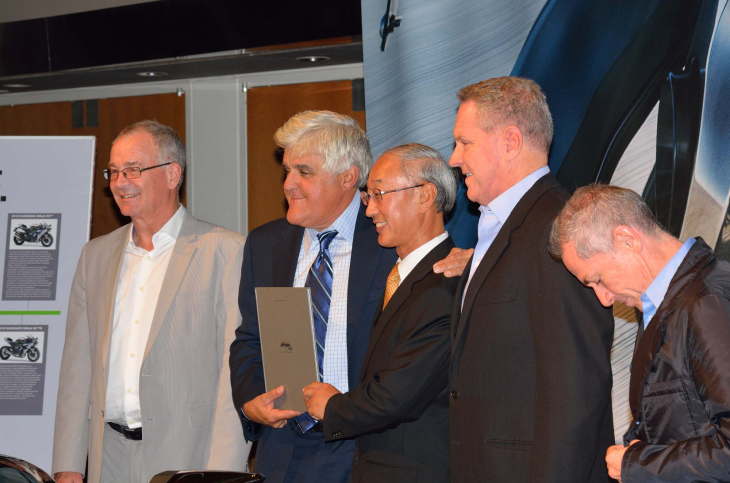
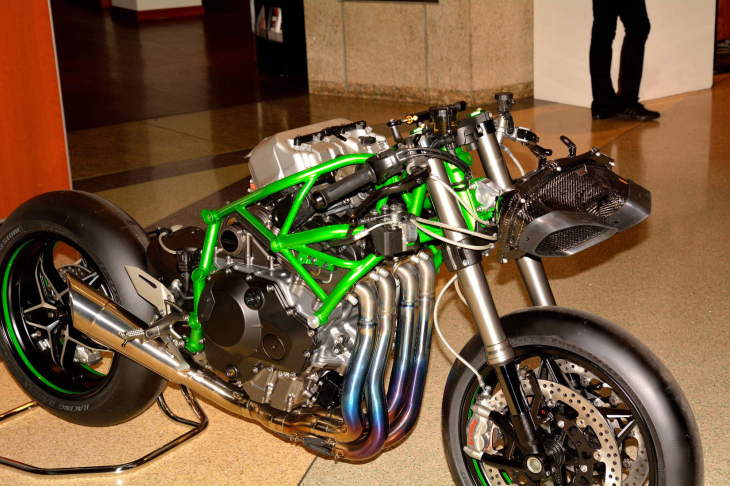
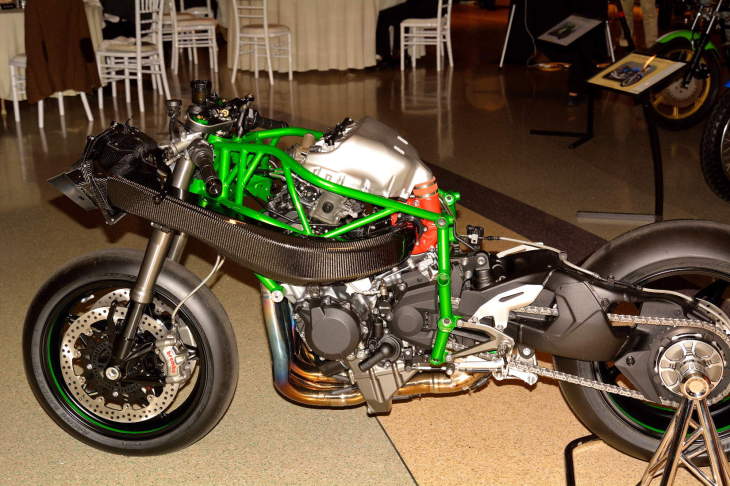
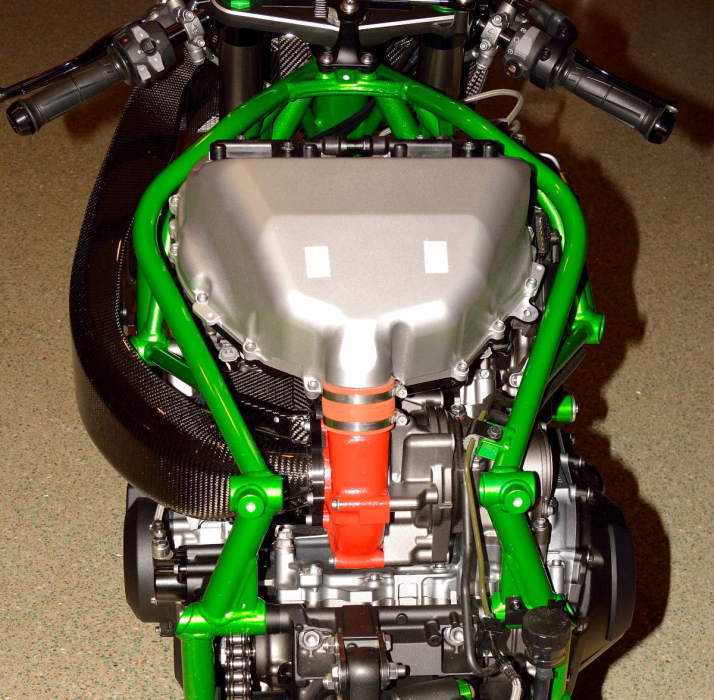
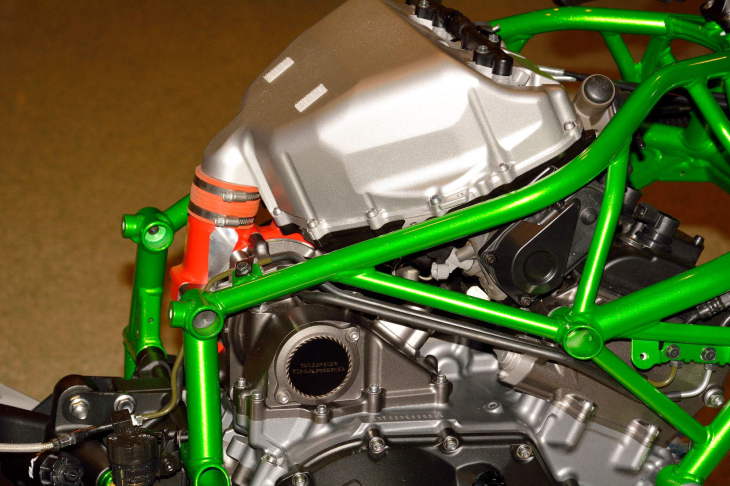

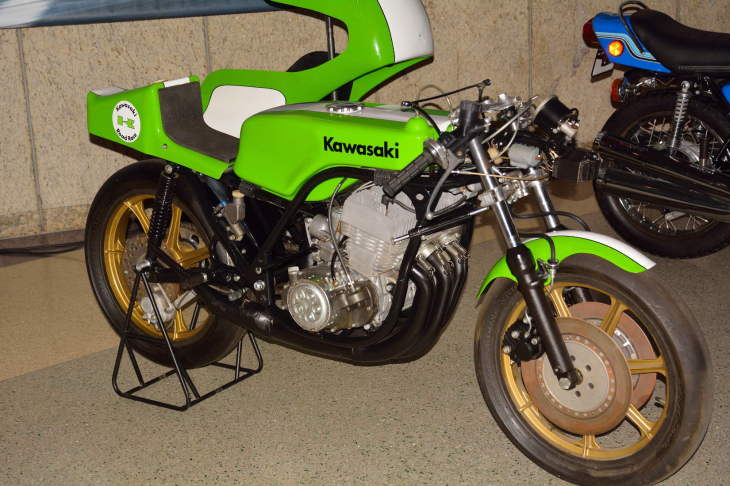
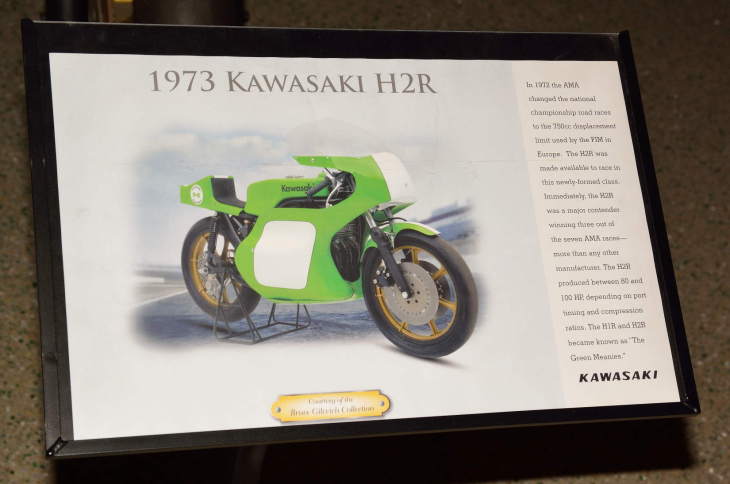
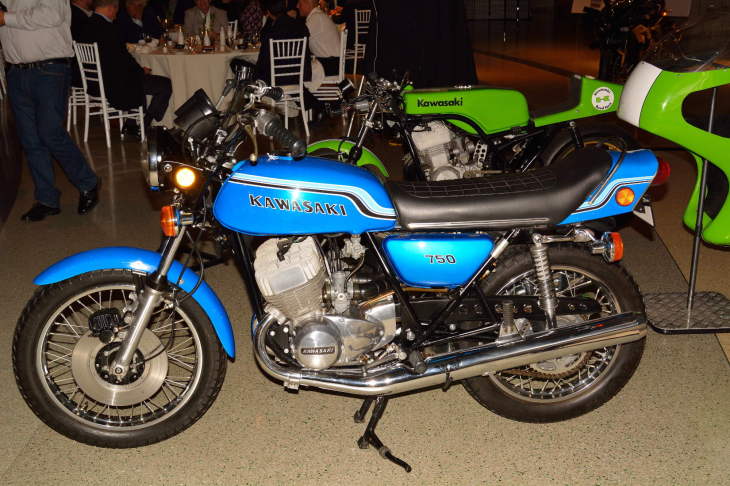
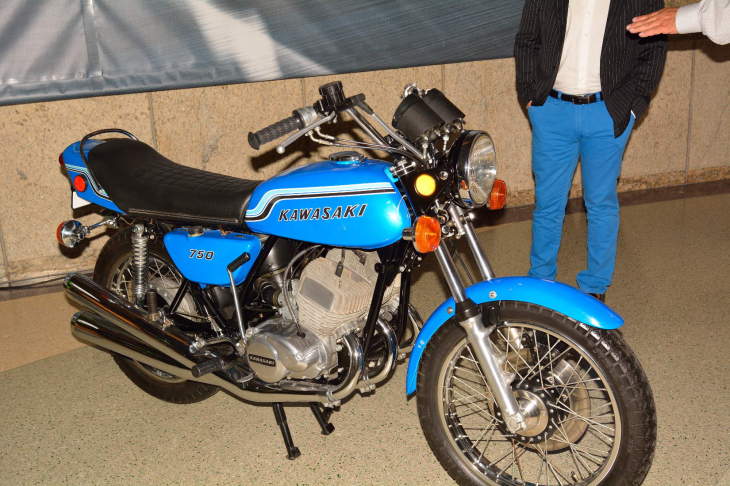
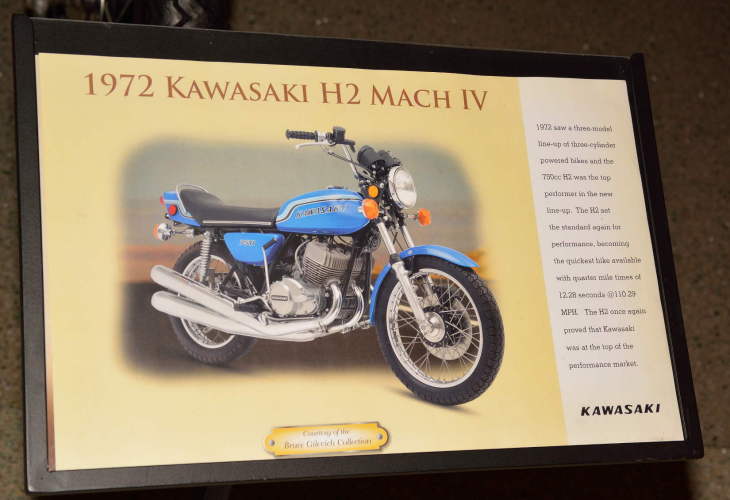






Now we can pick up most of the extras from Habbo Website 😀
Too fat.. too complex.. too expensive..
& so like how Honda – would approach doing a 4-stroke chainsaw..
2-stoke mills ( & Kawasaki COULD do a new clean, green, & mean 2-stroke triple H2)
are ideal for performance bikes.. ..peppy, light/powerful & exciting to ride..
& a big displacement 2-stroke can be tuned to be very tractable, yet still be lighter &
more powerful than an equivalent lazy ol’ 4-stroke..
To make a 4-stroke do real work it has to be boosted &/or rev its nuts loose..
& that makes it heavy/expensive/complex, just like this new Kawasaki.. ..or a Honda chainsaw..
You would think Kawasaki could make this thing a little better looking. Top performance but not so good looking. Does Japan know how to built a fashionable bike? Compare an MV or Ducati to this.
I personally think it is gorgeous (other than the desperate need for a tidy tail kit) while at the same time still being clearly a Japanese design.
re: “I spent last evening with Kawasaki representatives and roughly 25 journalists and other guests at the Japanese American National Museum in Los Angeles.”
last evening or October 8th…? help me out here. talk to me goose.
Its a Ducati 998 painted green with a Supercharged I-4 stuffed into it.
It sounds like it should be hoot to ride. Lets see what the journalists say after they get their “oh so skilled” and “well informed” hands on one of these green beasts so they can tell the rest of us how the price tag and the power output are both out of reach for more than 95% of interested riders.
Sorry, forgot the link: http://www.youtube.com/watch?v=bfLqa4vlmFI
0 to maximum speed: Ducati 1199 vs. McClaren P1 vs. Porsche 918 Spyder. The bike lead only for a limited range, mostly in the 150-175mph range IIRC. Of course a cage achieved highest terminal velocity by good margin.
I demand retest with Kawasaki Ninja H2 replacing the antiquated (by comparison) Ducati. Possibly the cages will have superb view of the H2s rear till it quickly disappears.
What kind of chain and tires can withstand such abuse?
In Silicon Valley rush hour, McLarens have a superb view of the rear of my bicycle until it quickly disappears…… That’s how well suited those things are for current real world conditions….
I was totally serious about the gas mileage question. Not being familiar with superchargers, do they suck down vast quantities of petrol, do they consume gas comparable to non forced induction motors, or are they frugal with the amount of fuel they use?
What kind of mileage is this bike liable to get? Is it likely to get 20 mpg or 50 mpg in normal riding situations?
I am also astonished it can get by with a 530 drive chain.
re: “do they suck down vast quantities of petrol”
mad max says yes.
re: “do they consume gas comparable to non forced induction motors”
mad max says no.
re: “are they frugal with the amount of fuel they use?”
mad max says DEFINITELY no…
it’s all about chasing down toecutter and exacting REVENGE.
With a single speed blower, to avoid blowing the engine to smithereens at 14K revs or mindlessly pressurizing an already over pressured airbox, I’m guessing actual low rpm compression will be relatively low, yielding less than stellar efficiency. Throw in the drag of the supercharger and added oil and coolant pumps, and I doubt you’ll see more than mid 30s even with grandma at the controls.
Conversely, though, the high pressures may keep compression high enough at the top of the range, to allow it to be an unusually “frugal” steady 180mph autobahn commuter. Allowing German MC enthusiasts to move further from work into cheaper real estate locations. If nothing else, that’s one way of rationalizing plopping down $25K for a cool bike…..
I agree with Barry however it might not be feasible to sell a brand new street legal 2-stroke motorcycle due to emissions. Kawasaki might have gone for a 4-stroke triple naked bike, like the early 2000’s Triumph Speed Triple.
And now when us oldies are searching for Kawasaki H2’s on the internet we’re going to stumble on ads for the 2014 bikes, which is not what we’re looking for.
At $25K a pop and a limited production, I reckon the number of false positive 2014s you’ll have to wade through on your quest for a 70s bike, will be manageable….
Missing the point about the original H2 comment.Nobody said this is not a cool new bike by Kawasaki and its good to see Kawasaki step out.The point is this bike has nothing to do with the H2 or the H2R name,at all !!!! This bike is just the next step in the Ninja,Transformer,Plastic,Squid Bike race !! All the manufacturers are working on Turbo and Supercharged bikes !!!! Putting down a 40 year motorcycle is easy to do,but I would bet if any of the big manufacturer would came out with a modern 2 stroke street bike at a decent price it would be a big hit,sell well and be more fun to ride than these limited production,expensive transformer bikes !!!! Listen to your elders young squid,you might learn something !!!!
Do modern 2 stroke engine bikes achieve current emission standards ?
If they DO satisfy current emission standards, the question remains “how long for” given the ever tightening emission constraints. Why would an engine manufacturer tool up a great expense to produce a short-lived 2 stroke product ?
re: “The point is this bike has nothing to do with the H2 or the H2R name,at all !!!!”
defence will stipulate.
re: “All the manufacturers are working on Turbo and Supercharged bikes !!!!”
all the manu’s HAD forced induction kit, so realistically yes, they should be trotting out a mint GPZ750 Turbo…
http://tinyurl.com/oaqck2s
but alas it’s their detail.
re: “The point is this bike has nothing to do with the H2 or the H2R name,at all !!!!”
O.K., lets look at the similarities.
Handling…no
Triple…nope
2 stroke…nada
brakes…miss
bodywork…not even close
sound…don’t go there
The ability to randomly scare the crap out of yourself at the twist of the wrist…….we have a similarity, H2 it is!
BUT WAIT THERE’S MORE…!!!
or even still, trotting out this along with the GPZ…
http://tinyurl.com/lht78cs
rarer than hen’s teeth.
BUT WAIT HISTORY REPEATS ITSELF…!
sorry, I’d forgotten about that last bit of kit, but If you take a read you’ll see history’s repeating itself in more ways than one.
fast forward to 2014 (like so much race bike) and here’s one of the disclaimers you’ll be signing off on should you fancy purchasing the “RRRRR” (best pirate voice)…
“Vehicle Warranty: The H2R is sold “As is” with no warranties, express or implied. The purchaser accepts all responsibilities concerning cost of service, maintenance and repairs”
this means YOU. read the rest from our friends at cycleworld…
http://tinyurl.com/p99r5mp
What a fabulous bike this will prove to be!
These things will be highly coveted collectors almost immediately.
The proof, of course, will be in the testing and comparison, but I’m convinced nothing will match the ‘speed-of-thought’ responsiveness of the engine. That alone, coupled with an upper level performing chassis will be enough to propel it to become THE must have street toy.
There is some concern that it’s outright horsepower, if only on par with the newest hardware, will dim it’s appeal, But there’s still a lot to be said for having that killah package.; Exclusive, techie, unique and powerful.
Nothing else like it on the road.
re: “That alone, coupled with an upper level performing chassis will be enough to propel it to become THE must have”
thank you, will you tell Ducati already…!?!?
re: “There is some concern that it’s outright horsepower, if only on par with the newest hardware”
pfft, laymen.
re: “But there’s still a lot to be said for having that killah package”
there’s a lot to be said for making proper comparisons and including ALL DATA not just the data that suits one’s argument.
trust me, I see the chatter. the bitch is the 524lbs (wet per 200hp) innit…?
right then, the Busa weighs 586lbs and the Zed14 weighs 590lbs (wet) and neither of are even close to 200 stock. personally, I see FAR more of those running around now in the post OCC/”exterior decorator” era than i do 1000cc supersports. dare i say they’re almost the equivalent of Harleys.
Want to see half of that motor in a trellis frame with single side swing arm for $12,500.
Don, please remove your pinky from the space bar! 🙂
re: “$12,500”
$15,000…
and not only will I throw in a pair of gloves…? but i’ll make sure we’re HERE (lights on and everything) when you return in 3 months for that 1st service and no charge warranty work.
Spread the development cost over way more units, so $12,500 it is. I still twist wrenches during the summer for a Kaw, Hon, Yam, Suz dealer and am well aware of customer expectations and wackadoodle flat rate times.
re: “(I) am well aware of customer expectations and wackadoodle flat rate times”
ok ok… $16,500 and that’s my final offer…? 🙂
Trying to comment and all it does is get lost in space. Hope the countless times I’ve attempted that they all don’t suddenly appear! :/ how frustrating.
H2?
nah
They should have called it “FUKIYA” which, (aside from the obvious F- you) means blowgun, a traditional weapon of the Ninja.
Great article. Once again, this is why MCD is the best.
I need more than 300hp on a bike to even consider getting out of bed….
You must get a lot of sleep.
I do.
You’re a big fella then?
I guess everyone’s different…. I’d be more concerned more than 300hp would quickly put me back in bed. A hospital one…
As I read some of the comments I wonder if some of the posters really know what this bike means to the two wheeled world. I’m sure every sanctioning race body out there are being bombarded from the likes of Honda, Yamaha, Suzuki, Ducati….. to change the rules in order to prevent this bike from competing at not only club levels but dare I say as high as the GP levels. If they can (and it looks like they have) put the power this engine is capable of producing to the pavement, in a chassis that remains rideable well lets just say in the hands of a good rider team green is destined for many podiums in the very near future. Win on Sunday sell on Monday. Without a doubt this bike is a game changer.
This bike is not legal for any racing series. There is no class for a 1000cc supercharged bike.
It will be a local drag strip and track-day bike, and there is sure to be a class for it at Bonneville, but other than that, there is no class it is legal for in any racing series.
There will be no lobbying by Honda, Yamaha or Suzuki. Why? Even at club level, most rules specify that forced induction is banned. Has been for a very long time.
Yeah if only they had enough pull to get the rules changed to suit them…….
If the Euros, Indians, Koreans and Chinese (and Americans, Go EBR…) keep encroaching on their sport bike markets, the Big4 may well lobby to allow forced induction. Or just create their own FI series’, hence rendering the official ones irrelevant.
By doing so, they can raise the cost of being competitive, to levels that will bury smaller makes the way Honda did at the end of the FI F1 era. Even a smaller OEM as tech savvy, race focused and fast growing as KTM, don’t have a gas turbine division to call up to optimize blowers, and an aerospace division to bring in to sort out aerodynamics at the speeds FI race bikes would be running.
The only thing keeping them from doing so, would likely be that motorcycling is growing rapidly in developing markets where low cost bikes are what sells, while it is stagnating in developed ones….
you might see some nutters run it on the island for the TT…? Macau, or FIM endurance (see Lemans/Suzuka) under special classification.
re: “Jeronimo”
this is what everybody coming off the dime should YELL inside the dealership the moment they plunk down their deposit…
that’d be cool. (Beavis and/or Butthead voice)
Dirck, Thanks for inviting us to the launch. My invitation from Kawasaki must have gotten lost in the mail again despite the fact that I’m a double K owner.
The decals on the old H2 are definitely misplaced. Odd that the big K didn’t catch that in such an important display.
Fabulous. It’s so much fun to see what human beings will do when powered by imagination and daring. I’d never ride or purchase one, but I love it.
My dad bought a ’72 H2 brand-new, which I have now – always stored indoors and all original right down to its tires and about 3300 miles. It’s also an early serial number, roughly around 2675 if I remember right. I have to remark that the angle of the tank stripe and ‘Kawasaki’ name on the ’72 H2 in the pictures is way off. It’s not supposed to be angled up so high. I’m assuming the example is restored? For basically my entire life, starting from some of my earliest memories as a child, I’ve often gazed upon an original H2 so that decal error glares out at me. Also, Kawasaki always claimed a 12-second flat 1/4 mile in their ads for the H2. They really emphasized it was 12 seconds flat. 🙂
Google 1972 Kawasaki H2 and it looks exactly like the one in the Kawasaki brochure pictured.
No, the only ones I see like the one pictured here are ones that had the decals placed incorrectly during restoration, and this one is especially bad. Kawasaki brochures sometimes show a slightly further-back placement of ‘Kawasaki’ but never at a steep angle. The brochure models were likely pre-production units.
Here is one that has the correct angle, just like my dad’s: http://michaelsmotorcycles.com/1972KawasakiH2750.html
http://motorbike-search-engine.co.uk/classic_bikes/1972-kawasaki-h2.JPG
Yes that one right. Now compare it to the one above which has an obvious extreme upward angle that it just wrong.
Oh and by the way, the placard for the H2 states there were three triples in Kawasaki’s lineup for 1972. Kawasaki had not only three triples in 1972, but four – the S1 250 Mach I, S2 350 Mach II, H1 500 Mach III, and of course, the H2 750 Mach IV. It seems the S1 is often forgotten…
Are you sure there was a 250cc triple oil burner? Strange, I thought I knew my 70s Japanese bikes better than that!
Indeed. http://www.motorcyclespecs.co.za/model/kawasaki/kawasaki_s1_250.htm
It is a very impressive piece of machinery. Wonder what kind of mileage it gets? How far do you think it can go on 4 1/2 gallons of gas?
Have to chuckle at the guys wanting a repro 750 H2. As ferocious as it was in 1975 it was slower in the quarter mile than the new Honda CB 1100 ( yep..look it up) which everyone thinks is such a dog. ( not me but then I actually own one)
Lets face it, they keep raising the bar on horsepower and light weight and now very few think a motorcycle with less than 150 BHP or over 500 pounds, is much of a motorcycle.
Crazy world.
Crazy indeed. 75hp is all I’d ever want.
right click save, right click save, right click save…
pictures of this bike undressed never get old. between the computers and phones I must have a 1000…?
Kawasaki designs and manufactures a production supercharged liter bike for $25K, with an impeller that’ll turn up to 130K rpm, and all people can do is complain about what it is not. Chowderheads.
Efn A…totally correct. I could not believe the price. They can’t possibly make money on it at $25k. A caged vehicle of this stature would cost more than 10x that price.
I’d like to just buy one and store it.
re: “store it.”
ride it…
for tomorrow we die.
A caged vehicle with this power train would not meet emissions regs. You just can’t do these kind of engines in street legal cars. As “high tech” as this is, simply making a humdrum Civic engine emissions compliant and sufficiently fuel efficient to meet competitive standards, is both harder and more expensive.
I’d like to see someone buy one of these bikes, throw away the lump in the middle, and install a real H2 750 2-stroke triple engine.
Now THAT would be cool!
So…. 70-80 HP is cooler than 300!?!? Who would have thunk that?
Who needs 300 bhp and all the electronics and complexity that come with it?
An 80 bhp 2-stroke triple in a modern chassis would do it for me.
+1, and if it was a modern direct injected 2 stroke 750 triple the number would be more like 150, not 70-80, although that would be plenty for me too. Look at what the current 2 stroke snowmobiles are producing. 300, or even 200 for the street is ridiculous, tons of fun, but still ridiculous.
Make that 80hp 2 stroke and someone will “complain” that something like this H2/R wasn’t made instead.
There is simply no pleasing everyone.
re: “There is simply no pleasing everyone.”
mickey has already given us a fine dissertation on how this works.
(insert copy/paste of mickey’s take on the FOCUS GROUP FROM HELL)
If Kawasaki really wanted to do something in honor of the H2 and the H2R name,they would give us a modern street legal 750-1000cc fuel injected,naked 2 stroke with vintage H2 graphics !!!!!! All else is just a slap in the face to our beloved original Kawasaki H2 triples !!!!! If you are going to talk about Kawasaki H2 triples,then it needs to be a 2 stroke triple !!!!! Keep the Ninja name for the 4 strokes !!!!!!!
Yes, that would be brilliant. I want a powerband so narrow as to be useless, and a 70 mile range on a 5-gallon fuel tank.
Why not throw on the ineffective brakes and a flexi-flier chassis as well? It’ll be just that much more fun with a bike that can’t stop or turn, right? Just like the original!
I, too, wonder about the H2 nomenclature, but more because the original H2 was such a piece of crap that it makes me wonder why they’d want possibly the most advanced road-going motorcycle ever associated with it!
Where do you guys come from?
assisted living centers most likely
Wow, I guess neither of you have any respect whatsoever for the elderly, that’s too bad. Also too bad you’ve never enjoyed the thrill of hitting the pipes (both sound and smell) on a multi cylinder 2 stroke street bike. A modern smoker in a modern frame would no doubt sell way more than these things. Having a broad perspective is a good thing, you should try it sometime, that’s if you can stay alive or out of jail long enough, as you seem to think 300 BHP machines are a good thing for the streets.
1) Who said anything about elderly people aside from the guy above? I only have an issue with people that are so constantly fixated on the past that they forget that 40 years of ‘stuff’ has happened… people that do that can be both young and old.
2) You’d be wrong.
3) A modern “smoker” still doesn’t solve any two-stroke issues that are inherent to the design. They’re very light, very simple, and can be made very powerful, sure! But they are tough to catalyze properly (and expensive when done), the rev band is useless for a street bike, and fuel efficiency is truly awful, which on street bikes can become a real problem. Road bikes need to be *clean*. By law. Pretty much everywhere in the civilized world. That’s why you only see big ones in boat motors and off-road vehicles, where such regs are lax. The two-stroke is a dead end for more reasons than just one, whether justified or not.
What makes you think that someone wouldn’t be building and selling two-strokes if there’s a market for them? For one reason : because they couldn’t design something modern, durable enough to make it through a warranty, clean enough to meet emissions requirements, efficient enough to make more than 75 miles to a tank of gas, AND still make money on it.
They have their high points – they make awesome off-road platforms, where light weight is #1, and simplicity is close behind. Some people think they sound/smell cool – I think they sound atrocious, though the smell doesn’t particularly bother me, but at least we can chalk that up to personal preference.
Also : the 300HP model is not for the streets. Kawasaki has said that from the beginning. It’s evident that the “street” model will be some degree less powerful.
So for those that really want big two-stroke multis : buy an original, or adapt an old engine to a newer chassis on your own. Because nothing that will sate that craving will likely ever be on the market again. An original would be cheaper than the Ninja H2, anyway, so why complain about this bike?
It may just be a dream to have a “modern” (looks like you missed this word above, as per your rant) 2 stroke for us older guys, but it’s a nice dream!!
Can’t blame you for dreaming of something, for sure. To each their own.
But calling a supercharged, 1000cc four stroke a “slap in the face” of a bike from the ’70s that didn’t really do anything well, other than go in a straight line (and even that was just relative…) is a bit of a stretch, per the original post we’re replying to. It’s Rose Tinted Glasses, to a really comical extreme!
Selecter, all due respect but do you really think 2 strokes are the same smoky, gas guzzling, high emissions engines that they were 40 years ago? If Rotax ever decided to put one of their 800cc e-tec engines in a modern sportbike frame, it would certainly be among the top performing bikes in all motorcycling. And that would come with good gas mileage, low emissions, and a wide spread of power. E-tec, look it up.
And if Rotax ever decided to put one of their two-stroke DI 800s (I’m smack in the middle of snowmobile country, so these aren’t new news to me), it would not be street-legal almost anywhere in the first world.
If there was the ability to make money on one, enough demand for one, and they could pass road-vehicle emissions regs, they’d be out there, rest assured. But they’re not. Because they can’t, there isn’t, and they wouldn’t.
Dig the special black paint. Kinda reminds me of the “black chrome” color of the exhaust pipes on Japanese street bikes from the 80s.